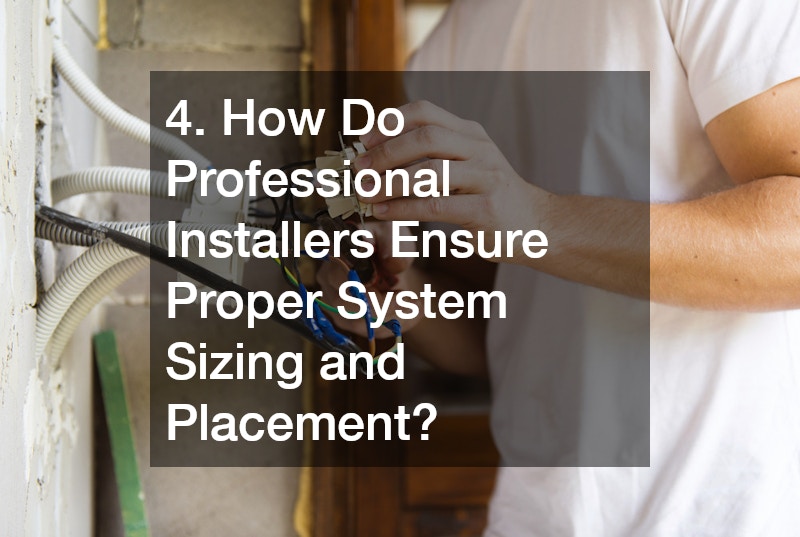
Heat pumps are an increasingly popular choice for efficient home heating and cooling. While DIY projects are tempting, installing a heat pump is best left to the professionals. This article delves into why professional heat pump installation is crucial, addressing common questions and concerns.
1. What are the Benefits of Hiring a Professional for Heat Pump Installation?
Understanding Expertise and Experience
Professionals bring years of experience and expertise that ensure a proper installation, maximizing the efficiency and lifespan of your heat pump system. They are trained to handle heat pump systems across various brands and complexities, reducing the likelihood of installation errors.
This expertise translates into optimized energy use, which is not only environmentally friendly but also cost-effective. Incorrect installations can lead to increased energy consumption and higher bills, defeating the purpose of investing in a heat pump.
Professionals are up-to-date with the latest industry standards and technologies, ensuring your system is installed with precision. Their knowledge allows them to navigate the intricacies of new technology efficiently and effectively.
Guarantees and Insurance
Professional services often come with guarantees, which offer peace of mind and financial protection for homeowners in case something goes wrong. These guarantees typically cover aspects of both labor and materials.
The insurance carried by professional installers safeguards homeowners from potential damage that might occur during installation. This is especially crucial in protecting against unforeseen issues that can arise with electrical systems.
Having a licensed professional install your heat pump ensures compliance with local codes and regulations. This is important for warranty considerations and potential future property sales.
2. How Does Professional Installation Impact Efficiency and Longevity?
Precision in Installation
A professional can ensure that the installation is precise, which is critical for optimal efficiency and reducing wear and tear on the system. Accurate installation leads to evenly distributed heating and cooling, enhancing comfort in your home.
Incorrect system placement or poor connections often result in system strain, leading to premature failures. A well-installed system avoids these issues and operates within its designed capacity.
Precision during installation also ensures that the manufacturer’s specifications are met, maintaining warranty validity. This means that any future defects can be addressed without additional financial burden.
Maintenance and Follow-up Services
Professionals often offer maintenance services that keep your heat pump running smoothly and extend its lifespan. Routine maintenance checks can help identify and rectify issues long before they become major problems.
Regular professional upkeep guarantees that the heat pump operates at peak efficiency, providing consistent performance throughout the year. This proactive approach minimizes the risk of unexpected breakdowns and costly repairs.
Many companies include annual maintenance as part of their installation package, providing value beyond just an installation service. These packages can also offer priority repair services and discounts on parts and labor.
3. What are the Safety Concerns with DIY Heat Pump Installation?
Electrical and Refrigerant Handling
Handling electrical components and refrigerants requires specific knowledge and certifications, which professionals possess to ensure safety. An improper electrical connection can pose a serious danger, leading to electrical fires or power outages.
Refrigerants used in heat pumps can be hazardous if not handled with care, requiring proper equipment for safe management. Professionals are not only trained in safe handling but are also knowledgeable about proper disposal methods to meet environmental regulations.
Moreover, adherence to safety standards during installation is vital in creating a secure home environment. Professional installers are aware of the operational limits and conditions necessary for safely running a heat pump system.
Risks of Incorrect Installation
Incorrect installation poses potential hazards, including fire risks and refrigerant leaks, that professionals are trained to prevent. These risks can be mitigated with proper equipment handling and adherence to safety protocols.
An inadequately installed system can lead to poor indoor air quality, posing health risks to occupants. Professionals ensure a sealed and correctly calibrated system, eliminating risks from airborne contaminants.
Incorrect installations may not meet homeowners’ insurance requirements, possibly affecting coverage in case of damages related to a faulty setup. Ensuring a professional installation mitigates such risks, offering both safety and financial protection.
4. How Do Professional Installers Ensure Proper System Sizing and Placement?
Assessment of Home Requirements
Professionals conduct a thorough assessment to determine the right size and placement of your heat pump system, tailored to your home’s needs. This involves analyzing various factors such as square footage, climate zone, and existing ductwork.
An appropriately sized system avoids the inefficiencies and wear associated with over- or undersized units. Proper sizing ensures optimal comfort levels are consistently maintained with minimal energy use.
By diligently evaluating your home’s specific requirements, professionals can mitigate issues related to inadequate or excessive energy demand. This detailed assessment is crucial for designing a system that ensures peak performance.
Customized Solutions
By understanding the unique layout and insulation of your home, professionals can offer customized solutions for efficient system operation. Every home is different, and professionals tailor installations to match individual requirements.
This includes factoring in household occupancy and geographic location, which can significantly influence system demands. Personalized system design supports sustainability and enhances overall user satisfaction.
Customization also involves the strategic placement of outdoor and indoor units to maximize operational efficiency and aesthetic appeal. Proper placement avoids unnecessary obstructions and ensures smooth airflow throughout the living space.



